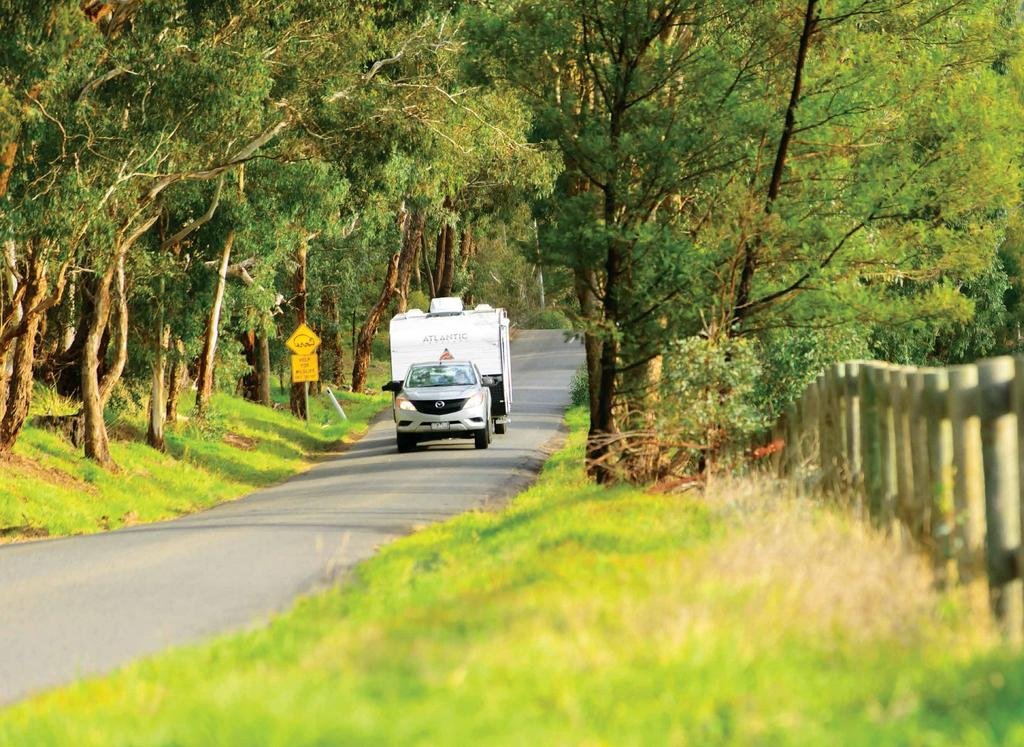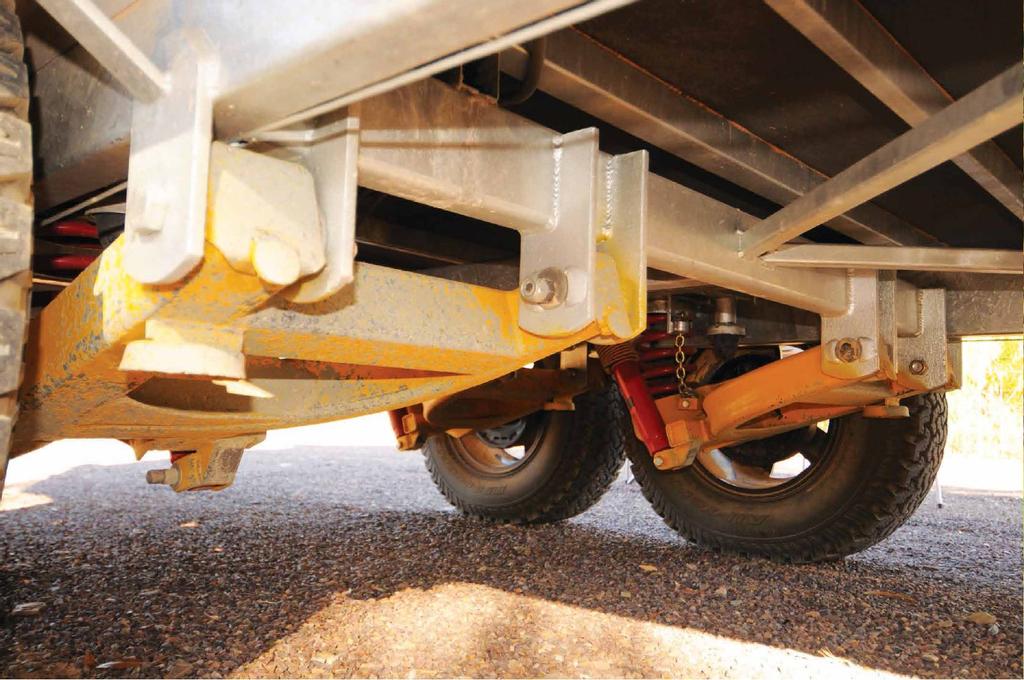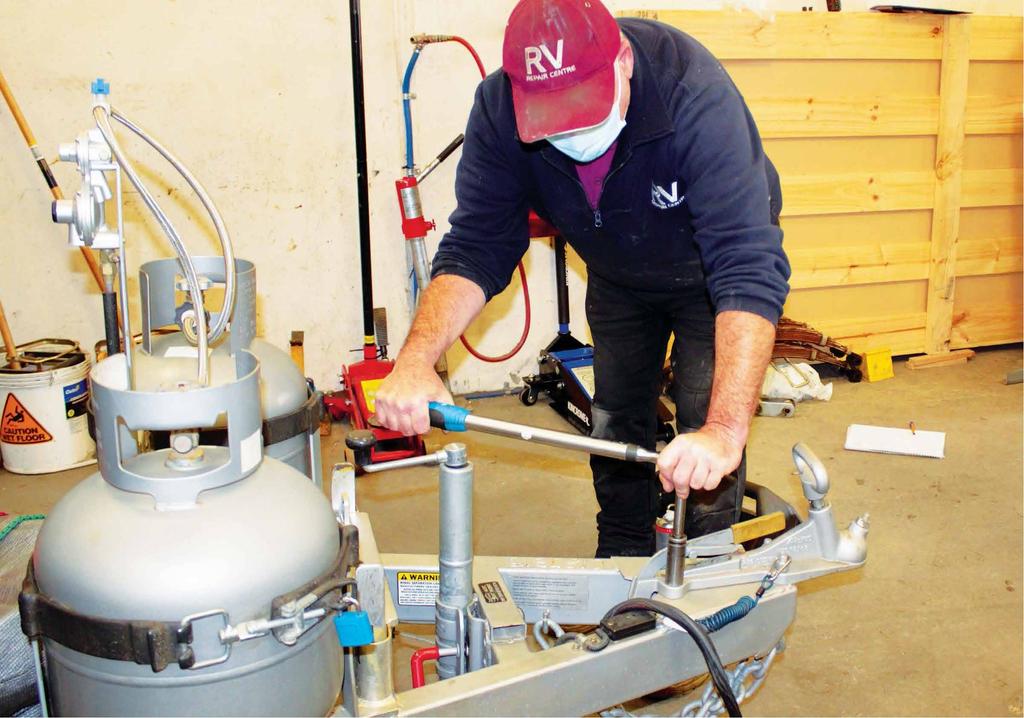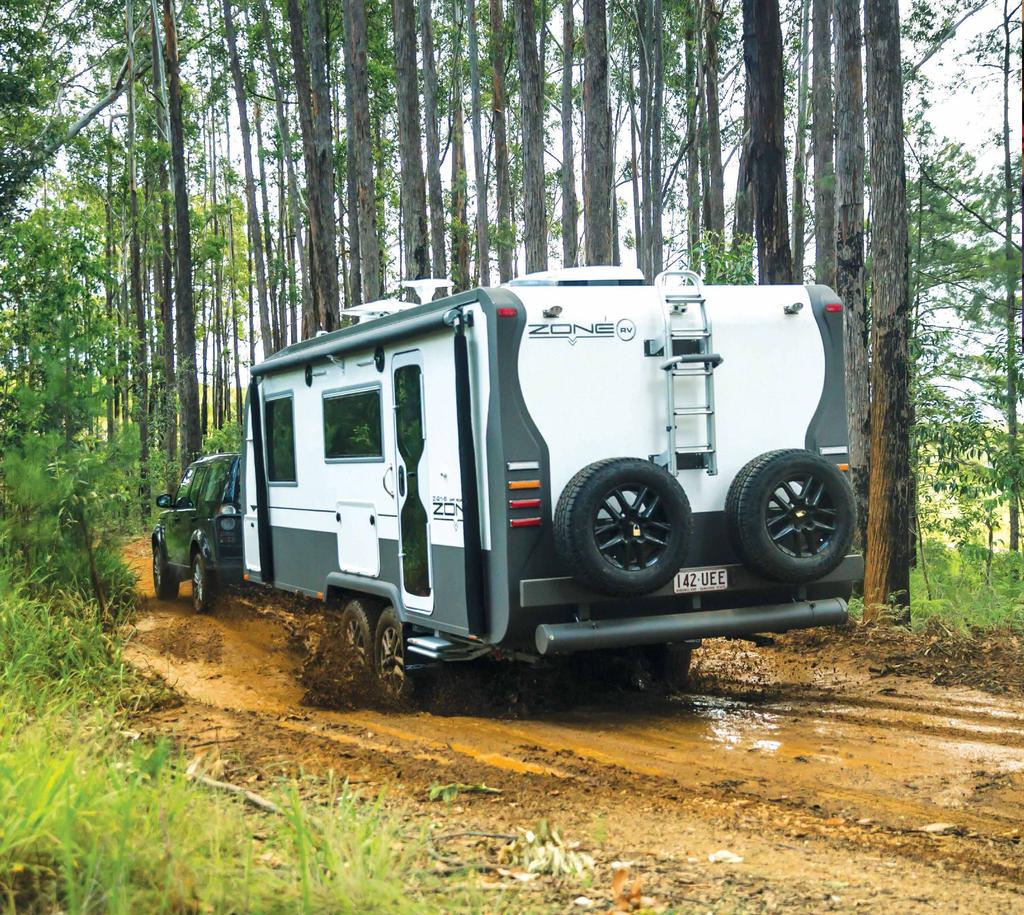Maintenance Matters

Speaking to Adam Twist from Suncoast Caravan Service, north of Brisbane, he shared similar thoughts, and added more vans now come with safety features such as breakaway and sway control devices and it is critical to ensure they are receiving power and functioning correctly. Adam emphasised the importance of keeping an eye on the often ignored electrical and plumbing as they play such an important part in safety.
WHEELS, BRAKES AND ASSOCIATED TECHNOLOGY
Let’s start with an easy one — check your tyre pressures are suitable for the job. Your caravan manual and the tyre wall itself will provide useful information. As a general guide, lower tyre pressures afford a more cushioning ride and higher tyre pressures are better for fuel economy and tyre wear. Rotating tyres every 10,000km is good practice to optimise wear. Often overlooked, tyres have a use by date of sorts — the tread may look fine but once your tyres are say six years old it is time to replace them. You can find the date of manufacture marked on the wall of the tyre. Of course, they could need replacing sooner if they show signs of deterioration or wear.
Wheel rims can be inspected for any major dents, signs of corrosion or cracking. Wheel nuts should be periodically checked that they are tight. A torque wrench is the ideal way to do this and can be used for many other tightening jobs.
Delving deeper, wheel bearings need to be regreased and adjusted to function correctly. It involves jacking the van up to remove the wheels for access to the bearings.

Suspension springs must be checked for cracks or breaks
Brakes are adjustable. This must be done as per the manufacturer’s instructions. Brake pads also require replacement when worn. The brake drums or rotors need to be measured to check they are within tolerance and inspected for signs of irregular wear. If the drum in electric brakes is replaced, a new magnet should be installed.
Breakaway systems are emergency devices that activate the van brakes in the event that the van becomes uncoupled from the tow vehicle. Generally, the system has some form of cable that attaches to the tow vehicle. If the van breaks away, the cable literally ‘tugs’ a switch in the system. Therefore, the cable and mounting hardware must be in good condition to do its job. The system generally also requires some form of electronic signal to be sent to the brakes. This relies on a battery in the system somewhere. An important maintenance job is to understand how this battery is charged and to check that the battery remains charged. Many devices have some form of system check that enables you to run a test observing LED lights following the manufacturer's instructions.
Many caravans are now fitted with electronic sway control systems that apply the caravan brakes in a swerving scenario. It is important to check they are operational. These systems also require power input to operate. They also have a system check, often through observing LED lights. This is an important one to become familiar with this by consulting the manual.
SUSPENSION
Most suspension systems are generally leaf spring type or independent arm type with coil springs. In either case, the springs need to be checked for signs of cracks or breaks. In the case of leaf springs, the U-bolts retaining the springs need to be checked to see they are in good order and the nuts are tight. Independent arm suspension systems tend to have grease points to enable regular lubrication. Both systems have shock absorbers that need to be checked for leaks. Both systems also usually have bushes at pivot points that need to be checked for deterioration.
A-FRAME, CHASSIS AND RELATED COMPONENTS
The A-frame and chassis are the spine of your van. The chassis in particular is out of sight, out of mind. Both should be inspected for signs of cracking or major corrosion which could lead to a failure.

The A-frame is the spine of the van, so it's essential that it be regularly checked
The coupling is the critical link in keeping your van connected to your tow vehicle. Couplings are generally attached to the A-frame with bolts and/or welding. Nuts need to be checked for tightness and again any signs of cracking or corrosion sought out. In the case of standard ball couplings, grease is applied to the coupling plunger and inside the coupling cavity. This helps with easier operation and to minimise corrosion and wear. Ball couplings also have an adjustment screw to enable a snug fit to the ball.
Safety chains are a backup to your coupling. They need to be strongly secured to the A-frame and each individual link needs to be in good order. Visually inspect for signs of cracks or corrosion and check bolts are tight where used.
Stabilisers need to freely move up and down to do their job when you park up your van. Being situated under the van they are exposed to a lot of dirt and grime. Regular cleaning and lubrication will prevent them from seizing up. If the stabilisers have been neglected for some time they can be dismantled for deeper cleaning, further lubrication and to replace internal parts if necessary.
The jockey wheel is also exposed to substantial road grime that eventually compromise internal moving parts. There is little maintenance that can be done externally. Internal maintenance is done by opening up the assembly to access the worm drive and bearing. Parts are then cleaned and lubricated or replaced if necessary.
Handbrakes need adjusting to compensate for brake pad wear and park brake cable stretching. There is usually some form of device to tighten or loosen to increase or decrease the tension on the cable. It should be noted that the actual brake mechanism also needs to be adjusted for correct operation for towing.
CHECK SEALS AND LOOK FOR WATER LEAKS
As it happens, this issue has a detailed article on how to check for water leaks. As an overview, water leaking in your van will damage metal and timber — the most common materials used for structural components. It can also cause mould and strong odours that can be very detrimental to your health. There is a lot you can do to check for leaks. Visual inspection is the best place to start, and prevention is always better than cure. Look all over the van where seals have been made. This is anywhere there is a ‘hole’ or a join in the van. When you look around and think about it, there are many holes in your van. This ranges from the big cutouts for air conditioners, windows etc., through to small drill holes where fasteners secure accessories such as awnings. Joins are anywhere materials overlap or butt up against another material. Examples include J-moulds that make a seal between the roof and the wall or silicone where cladding sections overlap.
You can’t always see seals but where you can, check for any signs of deterioration, breaks or displacement of the seal. Also, inspect throughout the van for any signs of where water has already been — this can include surfaces peeling away or feeling softer than they should, staining, swelling or wrinkling.
You can often pick up signs of dampness by smelling it before you can see it. Another method is to use a moisture meter which is relatively inexpensive and easy to use.
ELECTRICAL
Visually inspect all the wires and connections you can access to see if anything looks amiss. Remember some wires go to powering important safety features such as the breakaway device and sway control devices. Inspect the trailer plug for loose wires, signs of corrosion or dirt build up that could compromise the electrical contact.
Allowing your battery to go flat beyond recovery is a common problem and an expensive mistake resulting in the need for premature replacement. Solutions include disconnecting the battery terminals or regularly charging the batteries via your solar panels, a trickle charger or a regular charger on a timer. You can double check that you storage/charging regime is working by regularly checking the battery voltage.
Solar panels are much more effective when they are clean. Wiping away dust regularly will significantly improve their performance.

Once you've checked everything, it's time to pack up for another trip
PLUMBING AND VENTILATION
A simple task is to inspect all gas and water hoses for signs of nicks, cracking or perishing. Also, check the gas regulator and fittings for any signs of obvious damage. Suspected leaks may be detected by spraying soapy water in the area of concern.
A gas bottle has an expiry date of 10 years. You can check the date of manufacture marked on the neck ring. Gas bottles can be recertified by a licensed tester who will mark a new date on the bottle if it passes. Gas appliances should also be checked by a licensed tester.
Check vents throughout the van to ensure they are not blocked. They aid airflow to prevent against carbon monoxide poisoning. Similarly, vans are fitted with LPG drop out vents at low points in the van to enable potential leaking gas to ‘fall away’. The drop out vents need to be regularly checked that they remain unblocked to allow the (heavier than air) LPG to drain away.
Hot water services have an anode inside the tank to protect it from corrosion. The anode is a magnesium, aluminium or zinc rod that is a sacrificial part that corrodes easily instead of the steel or copper in the tank. The anode needs to be replaced regularly before it corrodes away.
Many older caravans will have a hand pump at the sink. The internal seals will eventually fail meaning the pump will no longer draw water and/or water will leak out of the pump shaft during the pumping action. Replacement seal kits are readily available and easy to replace.
IF IN DOUBT, CONSULT A PROFESSIONAL
Improper maintenance could lead to injury, death or property damage. Maintenance work of this nature should only be undertaken by persons with suitable mechanical competence. Information provided is general in nature, not comprehensive and can only be taken as a guide. Individual discretion must be exercised and persons undertaking described tasks do so completely at their own risk. Publishers and creators of this content accept no responsibility for loss or damage.
MORE ARTICLES
For more in depth Caravan World articles, look at the following:
- caravan.hemax.com/News/3530/Rims_and_tyres_101
- caravan.hemax.com/News/3459/Wheel_Bearing_Check_And_Regrease
- caravan.hemax.com/News/12298/Shock_and_Awe
- caravan.hemax.com/News/12781/Coupling_Inspection_and_Maintenance
- caravan.hemax.com/News/12850/Stabiliser_Maintenance
- caravan.hemax.com/News/3529/Maintaining_a_jockey_wheel
- caravan.hemax.com/News/3099/DIY_Trailer_Plug_Replacement
- caravan.hemax.com/Destination/13731/Kitchen_Sink_Refresh







